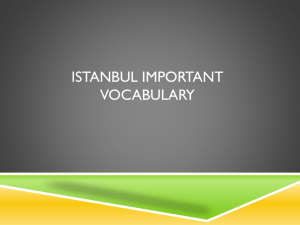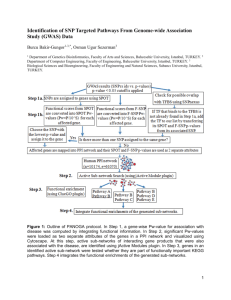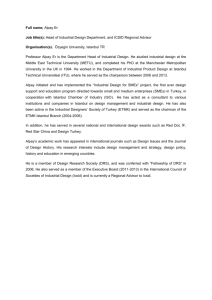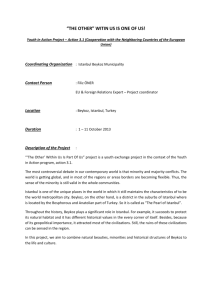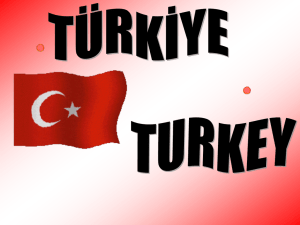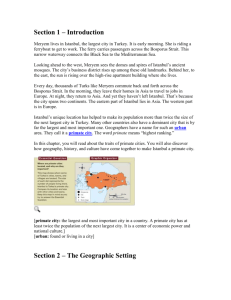turkey lesson plan outline - Turkish Cultural Foundation
advertisement
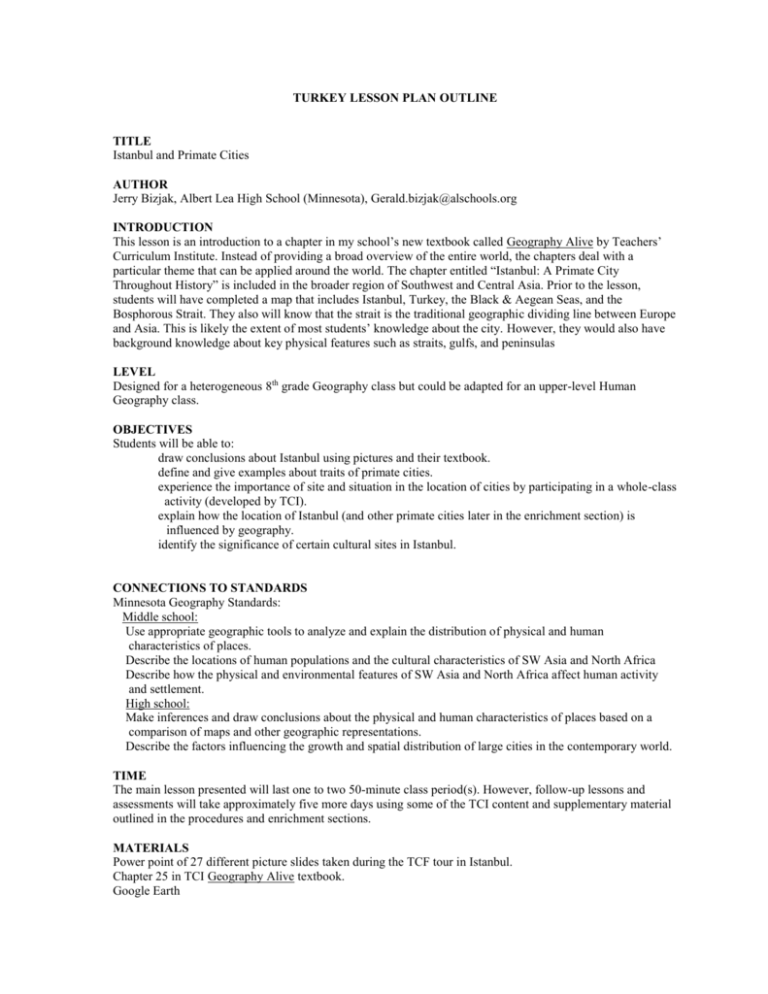
TURKEY LESSON PLAN OUTLINE TITLE Istanbul and Primate Cities AUTHOR Jerry Bizjak, Albert Lea High School (Minnesota), Gerald.bizjak@alschools.org INTRODUCTION This lesson is an introduction to a chapter in my school’s new textbook called Geography Alive by Teachers’ Curriculum Institute. Instead of providing a broad overview of the entire world, the chapters deal with a particular theme that can be applied around the world. The chapter entitled “Istanbul: A Primate City Throughout History” is included in the broader region of Southwest and Central Asia. Prior to the lesson, students will have completed a map that includes Istanbul, Turkey, the Black & Aegean Seas, and the Bosphorous Strait. They also will know that the strait is the traditional geographic dividing line between Europe and Asia. This is likely the extent of most students’ knowledge about the city. However, they would also have background knowledge about key physical features such as straits, gulfs, and peninsulas LEVEL Designed for a heterogeneous 8th grade Geography class but could be adapted for an upper-level Human Geography class. OBJECTIVES Students will be able to: draw conclusions about Istanbul using pictures and their textbook. define and give examples about traits of primate cities. experience the importance of site and situation in the location of cities by participating in a whole-class activity (developed by TCI). explain how the location of Istanbul (and other primate cities later in the enrichment section) is influenced by geography. identify the significance of certain cultural sites in Istanbul. CONNECTIONS TO STANDARDS Minnesota Geography Standards: Middle school: Use appropriate geographic tools to analyze and explain the distribution of physical and human characteristics of places. Describe the locations of human populations and the cultural characteristics of SW Asia and North Africa Describe how the physical and environmental features of SW Asia and North Africa affect human activity and settlement. High school: Make inferences and draw conclusions about the physical and human characteristics of places based on a comparison of maps and other geographic representations. Describe the factors influencing the growth and spatial distribution of large cities in the contemporary world. TIME The main lesson presented will last one to two 50-minute class period(s). However, follow-up lessons and assessments will take approximately five more days using some of the TCI content and supplementary material outlined in the procedures and enrichment sections. MATERIALS Power point of 27 different picture slides taken during the TCF tour in Istanbul. Chapter 25 in TCI Geography Alive textbook. Google Earth Masking tape 6 sheets of 5 different colored paper each Candy as a reward for students who “win” the game. World map with primate cities on it. BACKGROUND Because students are generally unfamiliar with Turkey, this lesson will serve as a practice/ungraded introduction to the country using Istanbul as the most important place geographically, historically, culturally, and economically thus making it a “primate” city. The other criteria for a primate city is that Istanbul has the over twice the population of any other city in Turkey. To build background based on prior experience, I’d ask students what the biggest city they have ever been in and to guess its population. If time would allow, the projector could be turned on to Google the population of that city as a way to compare it to the population of the school’s town (Albert Lea, MN is 18,000). There could also be a discussion about what they liked/disliked about that big city, why they went there, how it was the same/different from their hometown, etc. To build background based on prior knowledge, we’d review the names of the key bodies of water around Istanbul, that the city is a common geographic dividing line between Europe and Asia, and that it is not the capital of Turkey. PROCEDURES 1. Since most 8th graders enjoy odd questions, using a power point, I’d first show them a picture of a turkey and a gorilla and ask them what they think they have in common. They will likely not guess the correct answer so then I’d go to the next slide that would introduce the lesson’s title. (If desired, there is a link to the theory/story of how turkey the bird may have ended up with the same name as Turkey the country at http://blog.dictionary.com/turkey/ ). The next slide has a chart that lists the census figures provided by http://www.citypopulation.de/Turkey-RBC20.html along with an interactive link that shows various demographic information about the larger Turkish cities. Based on the census information, a little math could also be incorporated to find what percentage of people in all of Turkey live in Istanbul. 2. Students would then be prompted to guess if there is a primate city in the U.S. (technically there is not based on the definition but many may likely guess New York City or Washington D.C.). Online factchecking could also be done if time allowed. The next slide has the definition of a primate city (primate meaning “the top” or “highest ranking”) which includes the criteria in the first paragraph in the background (2x+ the population of the next largest city and the geographic, historic, cultural, and economic capital of that country). Students in my class are required to write down a Word of the Day and “primate city” would be that word. They then have to draw a small picture of the definition in their notebook. 3. Once the definition was written and drawn, Google Earth would be displayed on the projector screen and zoomed in on the straits connecting the Black and Aegean/Mediterranean Seas to remind students of the strategic importance of straits. Then Istanbul could be focused in on to show the geographic size of the city as well as more detailed locations such as the Golden Horn and Sea of Marmara. 4. Students would then partner up and open their TCI text to page 368 that shows an aerial view of the Hagia Sophia and Golden Horn. Students would then be handed a series of pictures I took on the trip (or others found online). The pictures would be printed off in handouts of three pictures per page. Using their text, they would have to scan the chapter and see if they could figure out where the reference to the picture is found in the book. On the lines next to each picture, they would write what they think the picture is of and the line and page number in the book that describes it. I would orally and visually give an example of the first slide which is of construction of the new Besiktas/BJK soccer stadium. In the book, following description of the ancient Hippodrome (which is also included as a picture), it says, “Turks still gather in Istanbul’s sports stadiums. But today they come to watch soccer. (374)” 5. After the example, the pairs proceed to the next picture(s) and continue scanning the text. If they are not sure of the picture reference, they could simply guess what it is and where it is referred to in the text. The teacher would go around the room monitoring the students’ progress, answer questions, and give hints. Depending on time, the teacher could cut down the number of pictures students would look at. Once most pairs have matched pictures with the textbook passage, the teacher should go over the answers and use Google Earth as a way to show students where these things are (additional pictures may be linked as well at the site). Followup questions should also be asked why students thought the picture matched the text. ASSESSMENT At the end of that class period or at the start of the next, a simple formative assessment for this activity would ask questions about the pictures. The teacher would display couple of pictures of Istanbul and students would write what makes a particular picture an example of a primate city. For instance, a picture showing a large traffic jam (answer: perhaps a high population) or one showing lots of skyscraper construction (answer: possible economic center growth) would be examples of possible correct responses. EXTENSION IDEAS A good transition that would follow the picture and match text lesson would be the interactive wholeclass game provided by TCI where students basically are assigned a “home” (there are six different “homes” connected by “roads” of masking tape) and then they have to trade various colors of paper in a series of rounds. The goal is to get the most different colored pieces of paper. The result is that students will want the home that is centrally located, connected by “roads” to every other “home”. This would then be a great time to show a map that displays the historic connectedness of Istanbul/Constantinople/Byzantium as well as the reason why the site of Istanbul has been and still is so important. Following the whole-class activity, students would use a world map with major cities on it and speculate as to what other cities could be primate cities. Students would then research various world cities and find traits in those cities that may make it a primate city. They could also pretend that they visited Istanbul (or other primate cities) and do a travel brochure about that city. They could also be asked higher-level thinking questions such as “What are advantages and disadvantages to primate cities?”, “What is the most important primate city in the world? Justify your opinion with reasons.”, or “Do you think primate cities will be more or less common in the future? Give reasons to support your opinion.” They could also look at the relationship between primate cities and capital cities. In the chapter, it says that Ankara was chosen as Turkey’s capital since it “had not been the center of ancient empires. By choosing Ankara as the capital city, (Ataturk) hoped to show the world that Turkey was a very modern place.” Students could research non-primate capital cities such as Washington D.C., Canberra, Australia or Brasilia, Brazil to find out why they were chosen as capitals instead of much more famous cities such as New York, Sydney, or Rio de Janiero. SOURCES Bergez, J., Burner, J., Apple, M. (Eds.). (2011). Geography alive!: Regions and people. (pp. 368-375). Rancho Cordova, CA: Teachers’ Curriculum Institute. (2013). The mistake that gave turkey (the bird) the same name as turkey (the nation). Retrieved from http://blog.dictionary.com/turkey/ Brinkhoff, T. (2013).Turkey: Registered population. Retrieved from http://www.citypopulation.de/TurkeyRBC20.html HANDOUTS See attached power point. Each page printed should be as handouts with three slides per page.
